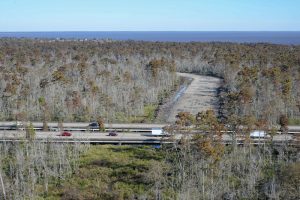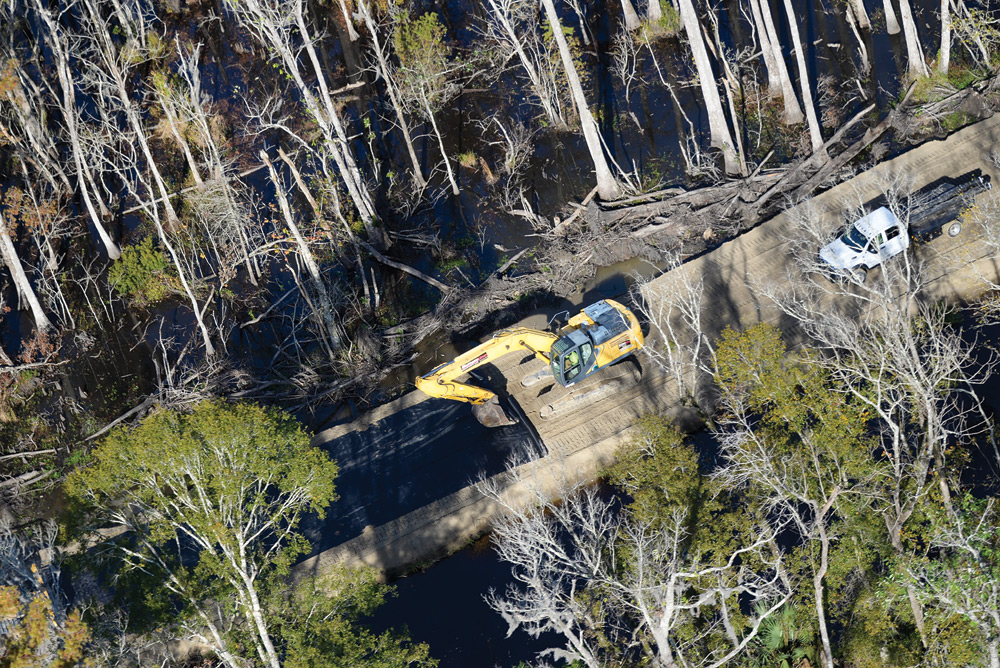The New Orleans Engineer District has awarded a contract for the second levee reach of the West Shore Lake Pontchartrain (WSLP) Hurricane and Storm Damage Risk Reduction project. The planned system will protect about 60,000 Louisianans in St. Charles, St. James and St. John the Baptist parishes against flooding from Lake Pontchartrain. The system of earthen levees, a T-wall, drainage structures and pumping stations will begin at the western guide levee of the Bonnet Carré Spillway and tie in to the Mississippi River levee near Garyville, La.
In March, The New Orleans District awarded the $25.5 million contract to Mandeville, La.-based B&K Construction, which will build “levee reach 107,” a 1.7-mile-long segment of earthen levee in St. John the Baptist Parish just north of Reserve. B&K will build the levee to an elevation of 9.6 feet.
The WSLP project, a joint effort of the New Orleans District, Louisiana’s Costal Protection and Restoration Authority and the Pontchartrain Levee District, will be an 18.5-mile system, including 17.5 miles of levees and a 1-mile T-wall. The estimated total cost is $760 million.
“Delivering the West Shore Lake Pontchartrain Hurricane and Storm Damage Risk Reduction project is a top priority for the Corps of Engineers and its partners, the Coastal Protection and Restoration Authority (CPRA) and Pontchartrain Levee District,” said Bradley Drouant, senior project manager with the New Orleans District. “This contract for construction of the system’s second large-scale levee reach is another important step toward achieving the federal, state and local commitment to residents of St. Charles, St. John and St. James parishes.”
The WSLP project, recognized as a need for decades, was first studied following Hurricane Betsy in 1965. Hurricanes, with their counterclockwise rotation, push storm surge toward the southern and western shores of Lake Pontchartrain as they move inland. At present, the Louisiana parishes that border the west shore of Lake Pontchartrain and Lake Maurepas have little to no protection from storm surge moving in from the lakes.
Those areas saw devastating flooding with Hurricane Isaac, which made landfall August 28, 2012, in Plaquemines Parish, La., with maximum sustained winds of about 80 mph. Storm surge from the lake flooded about 7,000 homes in the WSLP project’s impact area, with a stretch of Interstate 10 also underwater.

With renewed congressional support, the project was authorized in 2016 and funded in 2018.
Local, state and federal stakeholders of the project held a groundbreaking ceremony July 26, 2021, to mark the symbolic start of the project. Just over a month later, though, on August 29, 2021, Hurricane Ida made landfall near Port Fourchon, La., and slowly moved inland, flooding parts of the same area—even some of the same houses.
Preliminary service road construction for the project began in 2021, with the contract for the first mile of levee awarded on December 21, 2022. The Corps expects the entire project to be complete by 2026.
The West Shore Lake Pontchartrain system is designed to provide 100-year risk reduction, or protection from storm surge that has a 1 percent chance of occurring in any given year.
WSLP Mitigation To Include Diversion
Besides benefitting the communities that lay between the Mississippi River and the western shore of Lake Pontchartrain, the WSLP project will also include an innovative partnership between the Corps and CPRA on mitigation for wetlands impacted by levee construction.
Earlier this year, the Corps confirmed in the Supplemental Environmental Impact Statement for the WSLP project that it will consider CPRA’s River Reintroduction into Maurepas Swamp project (MSP) as a mitigation measure for WSLP.
The MSP will be a 2,000 cubic foot per second (cfs.) diversion on the east bank of the Mississippi River just west of Garyville. The project will reconnect the river, with its freshwater, nutrients and sediment, to the Maurepas Swamp that, prior to construction of the river levee more than 80 years ago, would benefit from annual flooding from the river. The diversion project is expected to benefit more than 45,000 acres of freshwater swamp.
“Implementing these projects together will not only breathe new life into a threatened ecosystem, but it will also provide greater protection against hurricanes and storm surge to over 60,000 Louisianans,” Louisiana Gov. John Bell Edwards said in announcing the partnership. “I commend CPRA and the USACE [U.S. Army Corps of Engineers] for recognizing the positive impacts of these projects and working together in the best interest for our state.”
CPRA and other non-federal sponsors will build the MSP. So far, more than $204 million in RESTORE Act funding has been allocated for engineering and construction of the project.
“When we combine risk reduction systems and restoration projects, vulnerable communities and the ecosystems around them both benefit,” said CPRA Executive Director Bren Haase. “The USACE decision is a win-win solution that will provide 100-year hurricane and storm surge protection to Louisianans while preserving a natural resource that is essential to our way of life in south Louisiana.”
State Sen. Eddie Lambert concurred: “The WSLP will provide enhanced hurricane and storm surge protection for the east bank of the River Parishes, while also restoring the degraded swampland in the Maurepas Swamp by infusing Mississippi River water. I am grateful that CPRA and the USACE have found a way to weave these projects together in a complementary way for the benefit of our state.”




